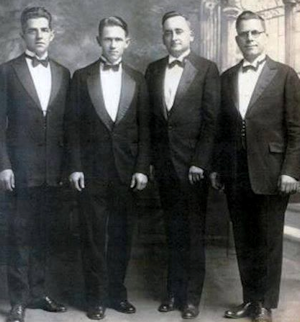 1927 Vaughan Quartet front l-r: Hilman Barnard & Otis McCoy back l-r: W B Walbert & Adger Pace |
Members1st Tenor |
The Vaughan Quartet (1910-????)
History
Members of the first Vaughan Quartet established in 1910 by the Vaughan Music Publishing Company included Joseph Allen (tenor), Ira Foust (alto), George W. Sebren (lead), and Charles Vaughan (bass) who was the youngest brother of James D. Vaughan. Foust initially sang the alto line one octave lower than written, which sometimes caused conflicts with the bass part.
In 1912, James D. Vaughan put three new singers with Charles Vaughan and three more new singers with George Sebren to create two separate Vaughan Quartets. In these groups, rather than having a man sing the alto line down an octave as Foust had done in the original Vaughan Quartet, the position of “first tenor” was created where the man sang the alto line at the original pitch. This method gave a better balance with the bass line than before.
By the mid-1920s, there were as many as sixteen Vaughan Quartets operating. In the late 1920s, one group was identified as the Vaughan Radio Quartet due to their popularity on Vaughan’s radio station WOAN while another group was billed as the Vaughan Recording Quartet due to their talents in the recording studio. The Speer Family and the LeFevre Trio were associated with Vaughan in their early years. The Vaughan company quartet performed on WSM radio in Nashville, Tennessee until 1939. Ottis Knippers first sang with the company Vaughan Quartet in the 1930s. He hosted a Sunday morning radio show in Lawrenceburg almost until his death in 2000.
Another popular Vaughan group was not a quartet, but a duet. The Happy Two consisted of Arthur B. Sebren (brother to original Vaughan Quartet lead singer George) and Cullie G. Wilson. They traveled together from 1925 to 1931 and with their combination of wit and musical skills, they were frequently the top songbook selling team in the entire company. The Happy Two’s most famous recording is “Rocking On The Waves” which was written by Sebren. Years later, Lee Roy Abernathy and his pal Shorty Bradford brought back the Happy Two name and performed complex arrangements including “Rocking On The Waves.”
In the early 1940s, there was a version of the Vaughan Quartet based in Birmingham, Alabama that included Lee Smith (tenor); Ernest Braswell (second tenor); Ray Morse (baritone); Clarence Ensey (bass); and Amos Mashburn (accompanist). Mashburn later performed with the Stamps-Baxter Male Quartet. Smith later shifted all the way to the opposite end of the scale to sing bass with a regional group called the Golden Harvest Quartet.
